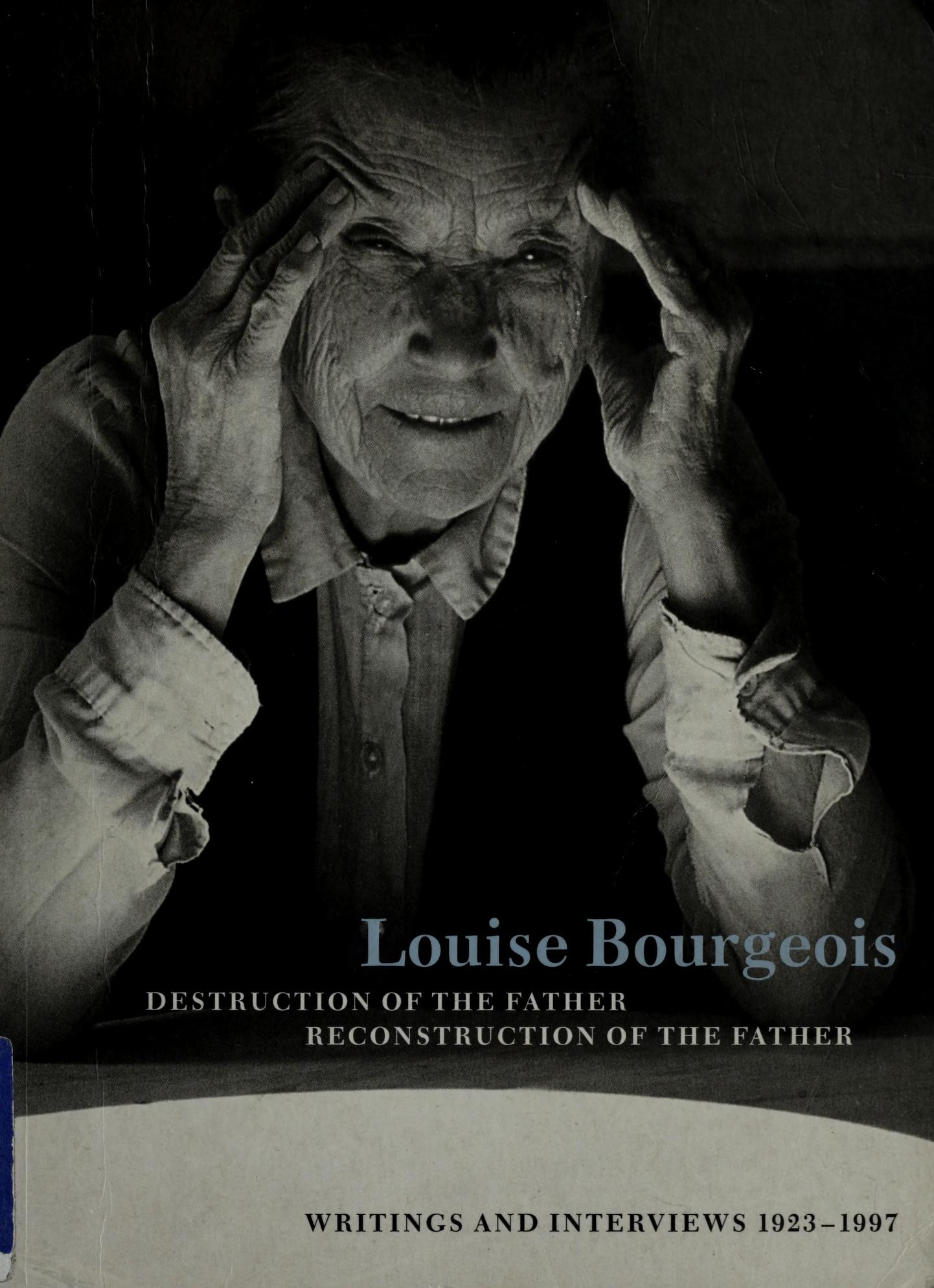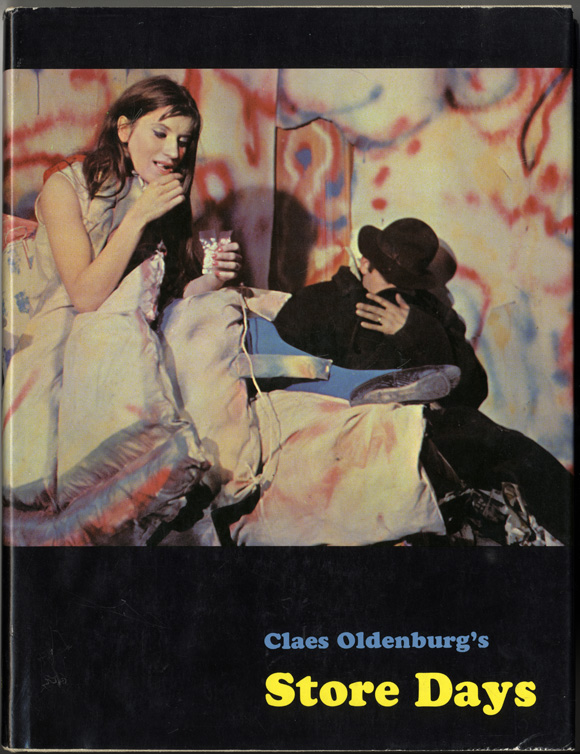Louise Bourgeois: Destruction of the Father / Reconstruction of the Father: Writings and Interviews, 1923–1997 (1998)
Filed under book | Tags: · art, art criticism, drawing, interview, sculpture

“‘Everyday you have to abandon your past or accept it and then if you cannot accept it, you become a sculptor.’
Since the age of twelve, the internationally renowned sculptor Louise Bourgeois has been writing and drawing; first a diary precisely recounting the everyday events of her family life, then notes and reflections. Destruction of the Father — the title comes from the name of a sculpture she did following the death of her husband in 1973 — contains both formal texts and what the artist calls ‘pen-thoughts’: drawing-texts often connected to her drawings and sculptures, with stories or poems inscribed alongside the images. Writing is a means of expression that has gained increasing importance for Bourgeois, particularly during periods of insomnia. The writing is compulsive, but it can also be perfectly controlled, informed by her intellectual background, knowledge of art history, and sense of literary form (she has frequently published articles on artists, exhibitions, and art events). Bourgeois, a private woman ‘without secrets’, has given numerous interviews to journalists, artists, and writers, expressing her views on her oeuvre, revealing its hidden meanings, and relating the connection of certain works to the traumas of her childhood. This book collects both her writings and her spoken remarks on art, confirming the deep links between her work and her biography and offering new insights into her creative process.”
Edited and with texts by Marie-Laure Bernadac and Hans-Ulrich Obrist
Publisher MIT Press, with Violette Editions, London, 1998
ISBN 0262522462, 9780262522465
384 pages
PDF (102 MB)
Comment (0)Claes Oldenburg: Store Days: Documents from The Store, 1961, and Ray Gun Theater, 1962 (1967)
Filed under artist publishing | Tags: · art, happening, installation art, performance, performance art, sculpture, theatre

““I’d like to get away from the notion of a work of art as something outside of experience, something that is located in museums, something that is terribly precious,” Oldenburg declared. In 1961 he presented a new body of work whose subject matter he had culled from the clothing stores, delis, and bric-a-brac shops that crowded the Lower East Side. The earliest Store sculptures, which debuted in spring 1961 at the Martha Jackson Gallery, at 32 East Sixty-Ninth Street, are wall-mounted reliefs depicting everyday items like shirts, dresses, cigarettes, sausages, and slices of pie. Oldenburg made them from armatures of chicken wire overlaid with plaster-soaked canvas, using enamel paint straight from the can to give them a bright color finish. At the gallery, the reliefs hung cheek by jowl, emulating displays in low-end markets.
In December 1961, Oldenburg opened The Store in the rented storefront at 107 East Second Street that served as his studio, which he called the Ray Gun Manufacturing Company. A fully elaborated manifestation of the project that he had begun months earlier, The Store conflated two disparate types of commerce: the sale of cheap merchandise and the sale of serious art. Oldenburg packed more than one hundred objects into the modestly sized room, setting previously exhibited reliefs alongside new, primarily freestanding sculptures. Everything was available for purchase, with prices starting at $21.79 up to $499.99. After The Store closed, on January 31, 1962, Oldenburg used the space to stage a series of performances collectively titled Ray Gun Theater.” (Source)
Selected by Claes Oldenburg and Emmett Williams
Photographs by Robert R. McElroy
Publisher Something Else Press, New York, 1967
152 pages
via penfold
PDF (83 MB)
Comment (0)Richard J. Powell: Black Art and Culture in the 20th Century (1997)
Filed under book | Tags: · abstract art, african american culture, art history, black people, contemporary art, cultural history, dance, diaspora, harlem renaissance, installation art, painting, photography, postmodernism, race, realism, sculpture, video

“The African diaspora—a direct result of the transatlantic slave trade and Western colonialism—has generated a wide array of artistic achievements in our century, from blues to reggae, from the paintings of Henry Ossawa Tanner to the video installations of Keith Piper. This study of 20th-century black art is the first to concentrate on the art works themselves, and on how these works, created during a major social upheaval and transformation, use black culture both as subject and as context.
From musings on the “the souls of black folk” in early twentieth-century painting, sculpture, and photography to questions of racial and cultural identities in performance, media, and computer-assisted arts in the 1990s, the book draws on the works of hundreds of artists including Jean-Michel Basquiat, Romare Bearden, Elizabeth Catlett, Lois Mailou Jones, Wifredo Lam, Jacob Lawrence, Spike Lee, Archibald Motley, Jr., Faith Ringgold, and Gerard Sekoto; biographies of more than 160 key artists provide a unique and valuable art historical resource.
Richard Powell discusses the philosophical and social forces that have shaped a black diasporal presence in 20th-century art. Placing its emphasis on black cultural themes rather than on black racial identity, this book is an important exploration of the visual representations of black culture throughout the twentieth century.”
Publisher Thames & Hudson, London, 1997
World of Art series
ISBN 0500202958, 9780500202951
256 pages
Reviews: Deborah Kempe (Art Documentation 1997), Steven Nelson (Art Journal 1998), Kymberly N. Pinder (Art Bulletin 1999), Elizabeth Harney (Nka 1999), Donna Seaman (Booklist).
Author (2nd ed.)
Publisher (2nd ed.)
WorldCat
PDF (59 MB, no OCR)
Comment (0)
